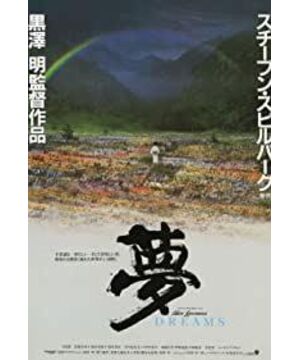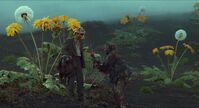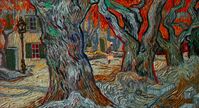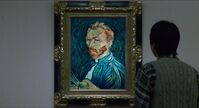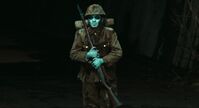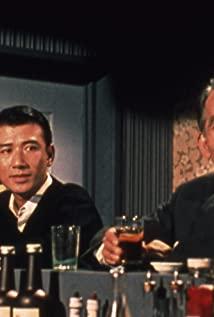The first dream: In a sunny and rainy day, the child refused to listen to his mother's admonition, and peeped at the fox's wedding, which angered the fox. The fox left a dagger to his mother, told her to pass it to the child and asked him to apologize with death. The mother drove the child out of the house and asked him to go to the fox's residence to ask for forgiveness.
The second dream: In Girls’ Day, a boy breaks into Taoyuan under the guidance of the "sixth girl" and talks with the soul of Taoshu. Taohun asked him to stay in this Taoyuan and be punished for the family who cut down the peach tree. Later, it was discovered that the boy was different from his family. He loved peach blossoms. So the souls of these peach trees brought him the last blooming peach blossoms.
The third dream: Several mountaineers encountered a blizzard on their way to the camp. Although the camp was nearby, their doubts about themselves and their teammates made them almost all killed in despair. When the last team member was dead, he resisted the temptation of death with strong willpower, and finally led the team members to the camp under the guidance of the sun.
The fourth dream: The officer walked through a long tunnel and saw his dead men on the other side of the tunnel.
The fifth dream: young people walk into the world painted by Van Gogh and visit Van Gogh.
The sixth dream: The nuclear power plant exploded, and toxic radioactive substances wiped out everything and turned the earth into ruins. A scientist, a young man, and a woman holding a child were forced to the beach, the scientist jumped off the cliff, and the young women were left in frustrated resistance.
The seventh dream: In a deadly ruin, the young man meets an "ogre". I learned that the world is deformed due to the effects of radiation. Humans become ogres, eating the weak and being tortured by the horns that grow from their heads.
The eighth dream: Youth came to a paradise. The people here follow the laws of nature and live a peaceful and stable life. The youth witnessed a "happy funeral" here.
Many sections of the movie adopt staged modeling and environment. In just ten minutes, although there were only a few people's dialogue activities, the identity of the characters was originally representative. Huge contradictions and conflicts are concentrated in scattered short stories, and the tension caused by various elements expresses more and more heavier and deeper intentions.
In the first dream, the little boy's prying behavior towards the fox is a kind of arrogance driven by the instinct of human curiosity. The boy represents the human camp and the fox defends the order of nature. The role of the mother acts as an impartial referee. The boy's adventure took place in the jungle. The dense trees, dappled sunlight and crystal rain showed the refreshing and translucent nature of nature. It also provides a mysterious and spiritual stage for the appearance of the fox. In terms of scenery, a large panorama is adopted. In terms of composition, the close-up is strong and tall trees, and only a small proportion of children walking in dense forests. The boy's immaturity and weakness form a strong contrast with the stalwart of nature. The shrines looming in the white mist and the soundtrack of traditional dramas "immortalized" the jungle (most Japanese traditional dramas originated from sacrificial activities, expressing a kind of awe of the gods), further creating an atmosphere for the appearance of foxes. The shape of the fox in the fog is not only stage-oriented, but also has the characteristics of traditional Japanese drama. From the modeling to the dance steps, it is neat and elegant. It portrays the fox's "god" identity while strengthening the concept of "order". At the same time, it alluded to the destruction of order by the children hiding behind the big tree. The first punishment for a child who disrupts order is to lose his "home". The closed door separates him from the simple and peaceful life of the past. The second punishment is "apologize with death." At the end of the story, the boy takes a dagger and walks towards the rainbow (the fox’s residence) among the blooming mountains. Here, the role of the rainbow is only to once again deify the fox, the "god" of nature, but it does not mean that the fox has forgiven the child. The flowers everywhere and the gray mountain view in front form a strong contrast in tone, heralding an uncertain future. Human beings should take responsibility and make atonement for their reckless behavior.
In the second dream, as the little boy moved, a tree of peach blossoms glowed softly under the sunlight. The surrounding dull tones and door frames all emphasized the peach blossom, making her look particularly holy and beautiful. Then the little boy entered the room, and the bright red cloth attracted the attention of the little boy and the audience with its bright and strong tones (of course, the purpose of the little boy's attention is also to attract the audience's attention). The Girls' Day dolls displayed on the red cloth are exquisite and gorgeous. It conveys such a message: Today is Girls’ Day (Japanese Girls’ Day dolls are usually collected). The shots of several dolls are getting closer and closer, and the lights make them crystal clear, and their expressions are lifelike, as if they are about to come alive, leaving a deep impression on the audience and giving the "Peach Soul" in Taoyuan a still life reference. As for the audience, when they see the later "Peach Soul", they will think of them and create contrast. As the boy watched the doll, the soundtrack of the traditional drama sounded. It is the same as the music that followed the dance of "Peach Soul". The film uses these two kinds of information to suggest to the audience that the "Peach Soul" the boy sees in Taoyuan is actually a doll for Girls' Day. In Japan, Girls’ Day dolls are sacred sacrifices with souls. The film equates the soul of the doll and the peach tree here, adding a fairy tale color on the one hand, deifying the peach tree on the other hand, and personifying the tree without emotion. So "Peach Soul", the representative of natural ecology, and the representative boy of humans began a dialogue between the two conflicting parties. During the conversation, the boy was at the lowest point in the terrain, so the camera often used overhead shots, and the status of "Peach Soul" was obviously superior. They (especially the king) have the power to rule. Their voices are ethereal and their costumes are noble, representing the sacred power of nature. However, the little boy they questioned obviously did not lose his natural love for nature. "Peaches can be bought with money, but where can I buy an orchard full of peach blossoms?" the child asked "Peach Soul". At this time, the subjective lens of "Peach Soul" was adopted. Through such a transposition, the child faced the lens and posed such a question to the audience and human beings. That peach petal rain was full, and the blooming peach blossoms took up the entire screen. Immediately afterwards, the abrupt peach tree trunks shattered the boy's dream, and also shattered the audience's hearts with strong visual contrast. At this point, the moving melody suddenly dropped by eight, and there was silence all around. With melancholy music sounded, the boy looked around, but there was only one peach blossom swaying in the wind.
The first and second dreams also used traditional Japanese theater styles to embody the mystery and sacredness of nature. The difference is that the first dream is about punishment, and the second dream is about reward. The first dream embodies the mysterious and harsh side of nature, while the second dream is its friendly and beautiful side. So in music, the first dream is relatively weird and gloomy, but the second dream has a taste of sacrifice or grand gathering. In terms of clothing, the fox’s clothing uses cool colors (even for weddings), while the "Peach Soul" clothing uses warm colors. Both dreams are about children, and they represent the dreams of a child. Therefore, whether it is the setting, the light color or the plot design, they are full of hazy fantasy.
The roar of the wind brought the audience into the third dream. The screen was gray-blue, with low visibility, and several climbers hobbled in a snow-covered world. The sounds of breathing, footsteps, and other movements are amplified to varying degrees. An avalanche occurred in the background, and the sharp and long ice in the foreground dropped from above, and thick snow accumulated to the human thigh. And the person's body is also covered with a layer of white snow. There was no dialogue for six minutes. The pictures and sound effects are monotonous to emphasize this harsh situation. This kind of opening gives people a feeling of despair, and makes people feel the kind of exhaustion, cold, menacing and hardship immersively. The audience will spend more than six minutes in a sense. The climbers also felt the time extension effect. The confused team member said the first line: "It's dark again." This undoubtedly adds to the despair. In despair, the players began to doubt: doubt the direction, doubt the time, and lost the perseverance to persist. Only the one walking in the front, he insisted that the time was right and the direction was right. "Our camp is not far away." He is the most sober one, which also shows that he is the one with the strongest willpower. This provided him with a personality basis for his subsequent escape from the temptation of death. One teammate after another fell. The god of death disguised as a gentle beauty and hypnotized him: "Snow is warm, ice is hot." The comforting requiem floated, and the team members almost fell asleep under the caress. And to fall asleep means death. When he tried to get up with his last will, a sudden blizzard's roar broke the quiet singing. In terms of sound effects, reality contrasts with illusions, reflecting the players' self-struggle in consciousness. Although his expression is still gentle, the hand of Death on the neck of the player is similar to choking his throat. Her hair was flying in the wind, and in the resistance of the team members, she finally recovered her hideous appearance and flew away with the wind. This is a dream about willpower. The level of resistance gradually increased. The first is the harsh environment. This can be seen and felt, so everyone mobilized their willpower to resist it. But the temptation is invisible. The beautiful face and the gentle smile are far from the concept of death. So the teammates fell down after saying "someone is coming". Temptation is the greatest test of willpower. There may even be viewers who do not know the true identity of the beauty after reading the story, and some even choose to sleep peacefully even if they know that it is the temptation of the god of death. This is the horror of temptation. The temptation described by the master not only tested the climbers but also the people who watched the movie. Since psychedelic makes people intoxicated, how many people are willing to choose to be sober? However, after driving away the god of death, the storm stopped abruptly, the picture became clear, the sun appeared again, and the beautiful scenery was only reserved for those who persisted to the end. The team members raised their eyes in the trumpet of victory Gu, saw the towering peaks covered by ice and snow, and snowflakes flying on the top of the peaks. Obviously, these empty shots either call up information or go out to frame, and then use the link effect of the montage to make them related, so that the joy of success is magnified in the studio through a beautiful scene. Of course, the tonal light in the studio must be carefully matched to these beautiful scenery. The beauty and expressions are switched alternately, rendering the joy of success. The camp was illuminated by the sun and set up exaggeratedly a few steps away. The intention is to express "If you don't give up in a critical moment, despair will become hope."
In the fourth dream, a man's clothing shows his identity as a soldier. The camera follows the soldiers, and the background turns from a natural scenery to a deep tunnel. Subjective shots of soldiers, the black tunnel is getting closer. Black represents death, sorrow and depression, while the tunnel implies a span of time and space, life and death. The soldiers walked towards the junction of yin and yang. A vicious dog ran out of the tunnel and barked at the soldiers. The scarlet light hit it, making it look more hideous and terrifying, as if it were an evil spirit that broke out of hell. The long dark tunnel and the sound of footsteps overlapping with the echo create a terrifying and gloomy atmosphere, which makes people uneasy. When the soldiers walked out of the tunnel, the night that symbolized death had already fallen. A sacrificed soldier walked out of the tunnel. The shape of the warrior is very staged: dark red blood penetrates deeply into the tattered military uniform, the skin is pale and bluish-gray, and the face is depicted like a skull through the exaggerated makeup effect. It was a horrible look of a dead man. In this way, the tragic deaths and survivors of the war were placed in a frame for dialogue. The soldier's first sentence naturally explained the protagonist's identity: "Commander. Did I really die?" The desire for survival and the attachment to his family made the soldier unable to believe that he had died tragically. Progressing step by step, one question after another, the commander was speechless and could only retreat step by step and was forced to the wall. In the picture, the soldier is in the upper left corner and the officer is in the lower right corner. The two extreme positions match the two extreme identities, and the tension is very high. The soldier pointed to a light in the distant mountains, turned his head, and said sadly: "Dad and Mom are still waiting for me to go home." This picture is quite beautiful. The mountains in the distance are already dark in the night, only the white light in the mountains is so bright, which points the way for the soldiers to return. But no matter how bright it is, it is only a little bit, so quiet, so faint. It's like a hope that is extinguished in a pinch. Soldiers nearby are looking into the distance, and relatives in the distance are waiting, but they are already separated by yin and yang, and they will never get close to each other. This is the appeal of the picture, and it is also the master's skill. If the camera is only at the soldier, no matter how big a close-up, no matter how sad the expression is, it is not enough to express this kind of despair. Such despair was brought about by war. It takes not only life, but also hope, peace and love. Innocence is death or life, and all have to suffer from it. The third team stood neatly at the entrance of the tunnel, and the captain reported: "No casualties." Based on previous movie-watching experience, the audience can tell from the appearance that they have actually all been killed. The extreme contrast between sight and hearing creates a sharp contrast between life and death, honor and humiliation. The commander’s self-blame and the horrific memories of the war are visualized as a dog, trailing from the entrance to the exit of the tunnel, from life to death. The terrible memories of the war will accompany him throughout his life. That is an irreparable trauma. In this story, through the dialogue between the dead and the living, Kurosawa reveals the crimes of the war fiercely. It is a foolish act that reveals the roots of human inferiority under the temptation of interests and the desire to conquer.
Saying goodbye to the raging wind and snow, saying goodbye to the tunnel of death, the camera shows Van Gogh depicted in oil paint. Youth in the mirror. The camera followed him showing a piece of Van Gogh's work. The young man picked up his suitcase, put on his hat, and walked into the world painted by Van Gogh. The camera uses these motion metaphors: it was Van Gogh who made this young man walk into the world of oil painting and into the world of creation. With the sound of Western classical melody, Van Gogh's masterpiece "The Carriage on the Suspension Bridge" came alive in the sound of laundry and conversation. The young man asked the washerwoman in the painting for directions. The washerwoman sneered: "Be careful, he has lived in a lunatic asylum." An understatement of ridicule expresses Van Gogh's embarrassment: even the immortal image he created with one hand laughs. He is a lunatic. It can be seen that he was so incompatible with the world at that time. Van Gogh's paintings did not praise Christ, did not reproduce the biblical story, did not flatter the nobles, and he sang the sun and praising nature all his life. His paintings are not as detailed and realistic as those of Leonardo da Vinci and Rembrandt. What he expresses is the passion, love for nature and yearning for light. Kurosawa was keen on painting in his early years, and becoming a painter may be a dream he never realized in his life. But he has the same artistic passion and perseverance as Van Gogh. They have also tasted bitterness that is not understood by the world. "Kurosawa to the movie is indeed like the samurai he created himself, with the persistence of martyrs, and even a bit of madness. It is this point that determines him, Spielberg, and Coppola, It is also different from Eastwood. In the eyes of these big figures in Hollywood, movies are at best a value in life, and for Kurosawa Akira, movies are life itself. Kurosawa once hid in the bathroom and cut his wrists to commit suicide. , The reason is that being unable to make movies leads to mental breakdown.” Kurosawa said: “I, subtracting movies, it equals zero.” This kind of madness and perseverance is reflected by Van Gogh in his eyes. An oil-painted Van Gogh saw a young man holding a drawing board in his hand. The first sentence was: "Why aren't you painting?"-you don’t need to stand behind and tremblingly worship me. If you love painting, you must Pick up the pen. And it is not me that you should worship, but the great nature. The master used a set of metaphorical montages to alternately switch between the scenes of Van Gogh's paintings and the scenes of the train moving, showing his passion and enthusiasm for painting. Kurosawa specially chose Van Gogh to "visit" him after losing his ears. In response to the world's doubts about his ear-cutting behavior, Van Gogh explained in the movie: "I can't draw my own ears, so I cut them off." Regardless of whether this was Van Gogh's original intention, this is Van Gogh in the eyes of Kurosawa Akira. For him, "Van Gogh, minus painting, equals zero." He is using Van Gogh to express himself and the state of his lifelong pursuit, and of course he also uses Van Gogh to praise the beautiful natural scenery. After Van Gogh left, the young man ran to the sound of the whistle of the train. The previous set of montages tied the train to Van Gogh's creative passion, so here, the whistle sound that shouldn't have appeared in the wheat field has become a symbol, which marks the spur of Van Gogh's spirit to the youth. Afterwards, the young man led the audience through Van Gogh's paintings by special effects, and the black and white scenes reflected a huge red sun. That is Van Gogh's logo. The painting is enlarged in proportion to the height of the youth, and the viewer can even see the bumpy oil paint. Using this special effect, Kurosawa gives the audience a chance to experience his inner world in depth and detail through Van Gogh's paintings. The story ends with Van Gogh's last masterpiece "The Crow in the Rye", returning from illusion to reality, echoing the beginning. Those crows represent the depths of the artist's loneliness and loneliness. Akira Kurosawa deliberately exaggerated the number of crows, and he vented the same sadness. Echoing the action of the young man putting on his hat at the beginning, the young man stared at "The Crow in the Rye" and took off his hat. On behalf of Akira Kurosawa himself, he paid a lofty salute to Van Gogh.
The tone changed from clear and bright to blurry and dark, and there was panic at the beginning of the sixth dream. The majestic Mount Fuji looks like an angry god in a sea of fire. Humans are like ants on a hot pot, running for their lives four strings down the mountain. The protagonist who goes against the trend is highlighted. The master's extraordinary composition once again produces metaphors and contrasts: the power disparity between the natural camp represented by Mount Fuji and human beings. After being enraged by the beautiful Mount Fuji, Japan became a purgatory, and the tiny humans were powerless to resist and could only escape for their lives. The cliff is littered with rubbish and ruins. Middle-aged men in suits and shoes began to act as "storytellers", telling the audience what happened. Various toxins that had no color were not only "stained" with color, but also floated in the air like a miasma. The film uses this technique to visualize the threat, making the conflict more obvious. It also bluntly shows that humans can no longer set foot on this land. A conversation led to the identity of the suit-wearing person-"I'm sorry, I am one of those people who deserve to die." These words came out together, and several people were instantly classified into different camps, and they were no longer pure. Refugees. Men, women, and children, these three types of victims are innocent, and vulnerable. They stood with the perpetrators, one side was frantically questioning and criticizing, and the other side looked at the miserable situation guiltily and listened to resentment. The perpetrator wore a suit, clearly exposing the benefits and status brought to him by the nuclear industry. However, the woman took two naive children and a baby on her back. On the one hand, she portrays her great motherhood, which contrasts with the cruel extinction, and on the other hand emphasizes their pitiful innocence. A big bang illuminated the middle-aged man's regretful and guilt face, and then he jumped off the cliff. After enjoying money and status, regret and destruction follow. This is the end of the perpetrator. The radiation spread to the edge of the cliff, and the man desperately resisted in the red smoke. The desire for survival has turned into a man's desperate struggle, appearing weak in the red smoke that fills the screen. The red smoke that symbolizes extinction has become denser, making people desperate and suffocating. This dream expressed Mr. Kurosawa's worries about the nuclear issue.
A land of dead ashes, sunlight casts onto a ruin through dense clouds. The young man walked for nearly four minutes, crossing the top of the mountain, passing through the miasma fog, and there was still a gray silence. Similar to the beginning of the fourth dream, Kurosawa deliberately repeated these simple screen messages for four minutes, in order to convey to the audience a kind of desolation without traces of life in the viewing experience. Suddenly a figure in ragged clothes appeared in the fog, looking strange and hideous under the emphasis of the shape, environment and posture. Although the white horns on his head are small, they attract the attention of the audience because of the high-key color of its own. In Japan, this is the shape of an ogre. Therefore, in the eyes of the Japanese, this appearance will be more terrifying and more moral: human beings' arrogance and selfishness have turned themselves into monsters that devour themselves. In addition, in the shaping of the environment, even the pronoun of beauty-flowers, has also become this appearance. Using deformed plants to set off deformed people, human beings overstepped their duty to destroy the harmony of nature, creating such an unsightly world and oneself. Humans are radiated into the appearance of ogres, living a life of cannibalism. Even at the juncture of cultural extinction and on the verge of extinction, class still exists: those with more horns oppress those who devour fewer horns. Here, the ogre is not only a storyteller and guide, but also a sharp accusation of mankind’s folly of destroying the living environment. By the scarlet pool, many "ogres" hissed in pain. The scene of this hell is using a strong visual impact to tell the world what scene is at the end of the road of destroying the ecology. Play a very good warning role. On the one hand, this dream once again uses radiation and environmental protection as themes; on the other hand, it also exposes the ugliest soul of mankind.
After narrating the seven dreams, the eighth dream that the master used to end was about death salute. At the same time, he also showed his ideal country to the world. There were no sharp daggers, no obtrusive tree stumps, no raging snow, no barking dogs, no explosive nuclear power plants, no deadly desolation. The beautiful nature is shown in front of the audience. After passing through the smoke and ruins, the waterwheel is spinning and the water is gurgling in the picture. Everything is peaceful and peaceful. The plain rural scenery suddenly seemed so precious. Such a scene undoubtedly produced a great contrast with the end of the seventh dream. The living conditions of one place every day make the audience intuitively make instinctive choices. In the dialogue between the youth and the old man, the old man’s tone was plain but pointed to human ignorance. Through their question and answer, the concept of "Waterwheel Village" collided with the concept of modern society. What the old man said is exactly what Kurosawa himself said: a living law that conforms to nature and returns to the original. In the process of speaking, the beautiful scenery and the expressions of young people are constantly interspersed to increase the persuasiveness of the old man's speech in the language of the lens. At the beginning of the story, a group of children lined up, picking flowers and placing them on a rock. Whether it is the actions of the child or the sight of the youth, the focus is on the stone. The topography of the stone is high and placed in the center of the picture frame. After the young man left, the camera stayed for a while. These emphasises make the audience curious and leave an impression on it. Later, using this foreshadowing, the story naturally introduced the theme of death praise. It turned out that it was the tomb of a ronin. Ronin has been wandering all his life, lonely and helpless, and he died as a guest. However, the people in Shuiche Village gave him a beautiful home. For him, death turned into a relief, a peaceful belonging. At this time, the looming celebration music came from outside the painting, and through the explanation of the old man, it was natural to gradually bring the death celebration into it. "When you get older, you will naturally die." People who make contributions to life should be respected after death. This is philosophical thinking and conformity to nature. The sunlight cast mottled light and shadow through the shade of the trees, and the villagers carried the remains and sang and danced all the way. After going through the bumpy journey of seven stories, it was a peaceful rest, a full stop, and bliss. It is also the final belonging Kurosawa aspires to.
This film is very experimental. During the two-hour viewing time, Kurosawa showed the audience eight unrelated short stories, each with a profound theme. How to highlight the theme in just ten minutes and play the expected role of enlightenment is a test of skill. The master tried his best to mobilize film skills such as environment, styling, action, composition and sound effects to make them participate in the narrative as fully as possible. The characters are very representative, and the lines not only hit the nail on the head, but from time to time there will be a large amount of preaching, and even represent Kurosawa himself, straightforwardly speaking out what he wants to express. This is a big challenge to the white space required by traditional art (especially in China). On the screen, it is said that Akira Kurosawa is different from mainstream creators, but instead pursues a flat composition. In the movie, the composition of some backgrounds has been expressed to the point where it is close to the stage background (especially obvious in the sixth and seventh dreams). Whether such an effect is good or not is a matter of opinion, but at the age of 80 years old, the master's innovative spirit that is still brave to try and challenge is worth learning. As mentioned at the beginning of the film, this is a dream I have had. Therefore, whether children or young people, they more or less bear the shadow of Kurosawa himself. Whether it is the aversion to war, the pursuit of art, the reflection of human beings, the appeal to environmental protection or the view of death, these are all questions that haunt Kurosawa's brain and accompany him through his life. Life is like a dream. This one dream after another is not only about life, but also about ugly or noble human nature.
View more about Dreams reviews


